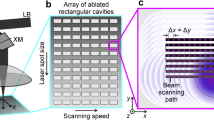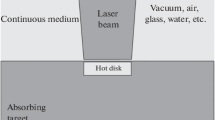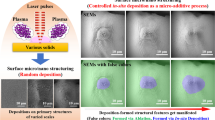Abstract
As the field of biomedicine continues to grow, so will the need for the quick and efficient manufacture of high-quality micro-textures, such as microfluidic systems, for biomedical functions. The utilization of a nanosecond-pulsed laser enables the realization of an efficient ablation rate in the preparation of a microscaled texture for biomedicine applications. To obtain high-quality ablated features, it is necessary to understand the interaction regime between the pulse laser and cermet. In this work, the effects of the scanning speed on formation mechanisms of microgrooves in pulse laser scanning ablation of cermet are investigated. The relative ablation processes in terms of the particle ejection and the morphology of the ablation traces under various scanning speeds are characterized. In addition, pump-probe shadowgraph imaging is used to observe the ablation dynamics and laser-plume interaction. The results demonstrate that the plume shielding effect, which stems from the intensive pulse energy overlap in the irradiated region, tends to occur at a low scanning speed and results in an intermittent ablation regime. Moreover, there is a critical scanning speed for overcoming the plume shielding effect when other laser parameters are kept constant. To realize an even and continuous ablation process, a high scanning speed that exceeds this critical value should be applied.
















Similar content being viewed by others
References
Liang L, Yuan J, Li X, Yang F, Jiang L (2018) Wear behavior of the micro-grooved texture on WC-Ni3Al cermet prepared by laser surface texturing. Int J Refract Met Hard Mater 72:211–222
Sun J, Zhou Y, Deng J, Zhao H (2016) Effect of hybrid texture combining micro-pits and micro-grooves on cutting performance of WC/co-based tools. Int J Adv Manuf Technol 86:3383–3394
Obikawa T, Kamio A, Takaoka H, Osada A (2011) Micro-texture at the coated tool face for high performance cutting. Int J Mach Tools Manuf 51:966–972
Kümmel J, Braun D, Gibmeier J, Schneider J, Greiner C, Schulze V, Wanner A (2015) Study on micro texturing of uncoated cemented carbide cutting tools for wear improvement and built-up edge stabilization. J Mater Process Technol 215:62–70
Pecholt B, Vendan M, Dong Y, Molian P (2008) Ultrafast laser micromachining of 3C-SiC thin films for MEMS device fabrication. Int J Adv Manuf Technol 39(3–4):239–250
Petare A, Mishra A, Palani I, Jain N (2019) Study of laser texturing assisted abrasive flow finishing for enhancing surface quality and microgeometry of spur gears. Int J Adv Manuf Technol 101:785–799
Zhu Y, Fu J, Zheng C, Ji Z (2016) Effect of nanosecond pulse laser ablation on the surface morphology of Zr-based metallic glass. Opt Laser Technol 83:21–27
Zhang F, Dong X, Yin K, Song Y, Tian Y, Wang C, Duan J (2018) Temperature effects on the geometry during the formation of micro-holes fabricated by femtosecond laser in PMMA. Opt Laser Technol 100:256–260
Kim B, Iida R, Doan H, Fushinobu K (2016) Mechanism of TCO thin film removal process using near-infrared ns pulse laser: plasma shielding effect on irradiation direction. Int J Heat Mass Transf 102:77–85
Kerse C, Kalaycıoğlu H, Elahi P, Çetin B, Kesim D, AkÇaalan Ö, Yavaş S, Aşık M, Öktem B, Hoogland H, Holzwarth R, llday F (2016) Ablation-cooled material removal with ultrafast bursts of pulses. Nature 537:84–89
Zhang F, Wang C, Yin K, Dong X, Song Y, Tian Y, Duan J (2017) Underwater giant enhancement of broadband diffraction efficiency of surface diffraction gratings fabricated by femtosecond laser. J Appl Phys 121:121105–122785
Dubey A, Yadava V (2008) Laser beam machining-a review. Int J Mach Tools Manuf 48:609–628
Stuart B, Feit M, Rubenchik A, Shore B, Perry M (1995) Laser-induced damage in dielectrics with nanosecond to subpicosecond pulses. Phys Rev Lett 74:2248–2251
Yuan J, Liang L, Lin G, Li X, Jiang M (2019) Experimental study on the laser-matter-plume interaction and its effects on ablation characteristics during nanosecond pulsed laser scanning ablation process. Opt Express 27(16):23204–23216
Pathak K, Povitsky A (2007) Modeling of plume dynamics with shielding in laser ablation of carbon. Appl Surf Sci 253:6359–6365
Man B, Dong Q, Liu A, Wei Q, Zhang G, He L, Wang T (2003) Line-broadening analysis of plasma emission produced by laser ablation of metal cu. J Opt 6:17
Dhupal D, Doloi B, Bhattacharyya B (2008) Pulsed Nd:YAG laser turning of micro-groove on aluminum oxide ceramic (Al2O3). Int J Mach Tools Manuf 48:236–248
Liu Y, Liu L, Deng J, Meng R, Zou X, Wu F (2017) Fabrication of micro-scale textured grooves on green ZrO2 ceramics by pulsed laser ablation. Ceram Int 43:6519–6531
Eaton S, Zhang H, Herman P, Yoshino F, Shah L, Bovatsek J, Arai A (2005) Heat accumulation effects in femtosecond laser-written waveguides with variable repetition rate. Opt Express 13:4708–4716
Bauer F, Michalowski A, Kiedrowski T, Nolte S (2015) Heat accumulation in ultra-short pulsed scanning laser ablation of metals, opt. Express 23:1035–1043
Jiang L, Pan C, Chen K, Ling J, Zhou W, Zhou J, Liang L (2015) Fiber laser carving under ice layer without laser energy attenuation. J Mater Process Technol 216:278–286
Obidigbo C, Tatman EP, Gockel J (2019) Processing parameter and transient effects on melt pool geometry in additive manufacturing of invar 36. Int J Adv Manuf Technol 104(5–8):3139–3146
Behzad F, Wayne SF, Gladius L, Ebrahim A (2018) A review on melt-pool characteristics in laser welding of metals. Adv Mater Sci Eng 2018:1–18
Ki H, Mohanty P, Mazumder J (2002) Multiple reflection and its influence on keyhole evolution. J Laser Appl 14:39–45
Yuan J, Liang L, Jiang L, Liu X (2018) Influence of the shielding effect on the formation of a micro-texture on the cermet with nanosecond pulsed laser ablation. Opt Lett 43:1451–1454
Funding
This work is supported by the National Natural Science Foundation of China (NSFC) (51575193); Guangzhou Science and Technology Project (201904010239); and Guangdong Natural Science Foundation Key Projects (2018B030311051).
Author information
Authors and Affiliations
Corresponding author
Additional information
Publisher’s note
Springer Nature remains neutral with regard to jurisdictional claims in published maps and institutional affiliations.
Rights and permissions
About this article
Cite this article
Liang, L., Yuan, J. & Lin, G. Effect of the scanning speed on the microgroove formation regime in nanosecond-pulsed laser scanning ablation of cermet. Int J Adv Manuf Technol 107, 97–107 (2020). https://doi.org/10.1007/s00170-020-05017-2
Received:
Accepted:
Published:
Issue Date:
DOI: https://doi.org/10.1007/s00170-020-05017-2




